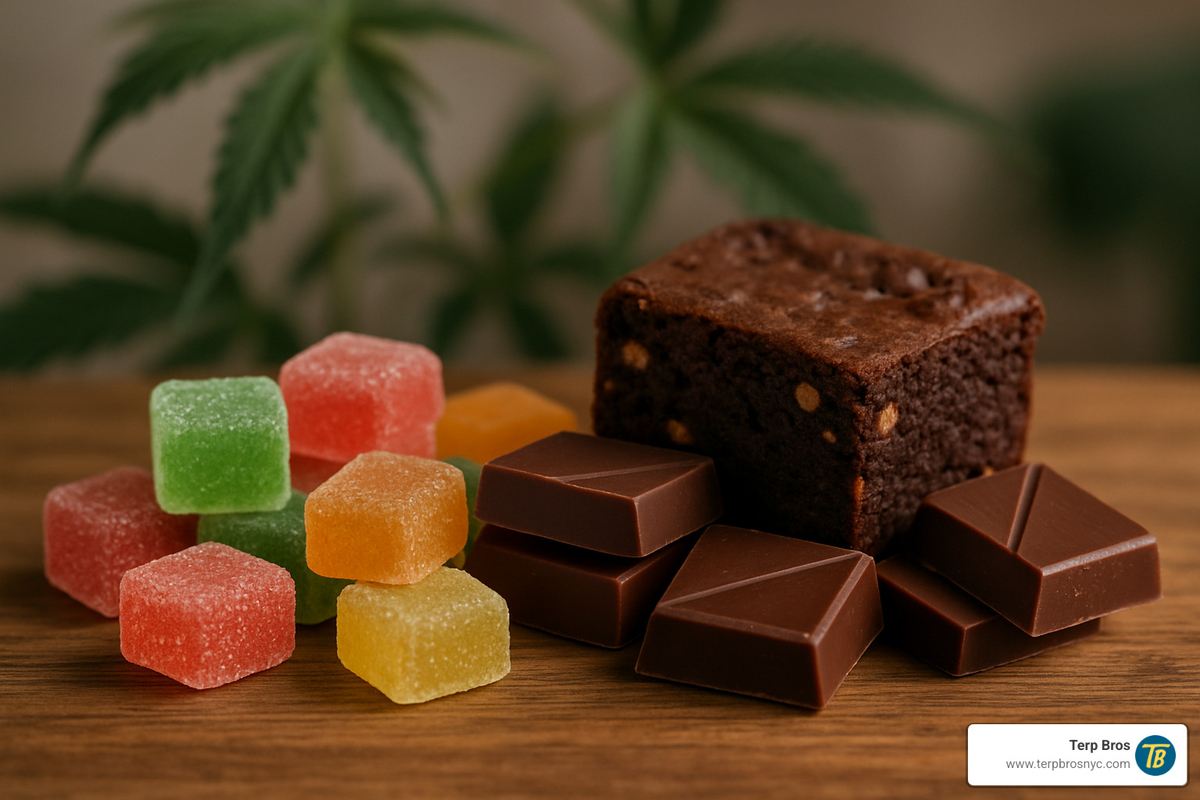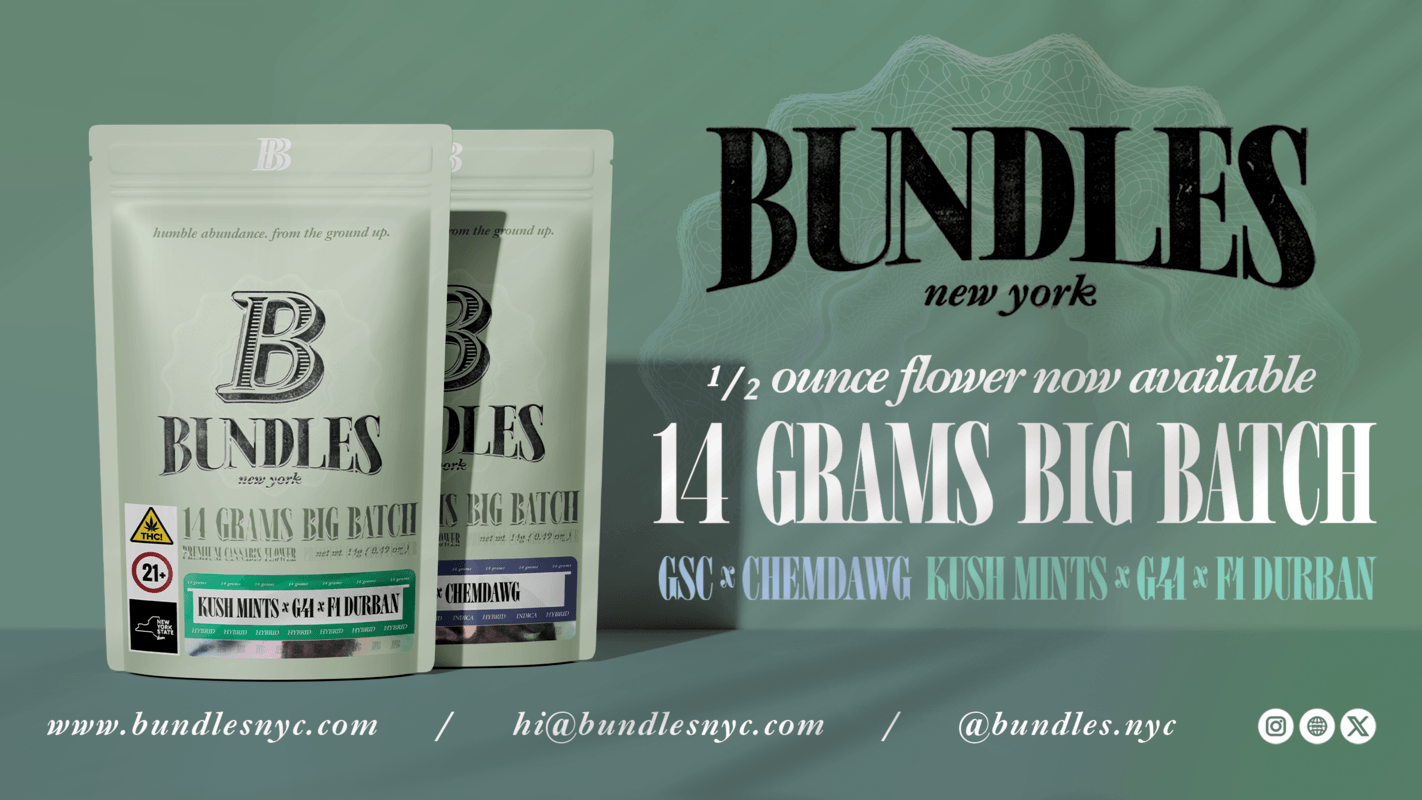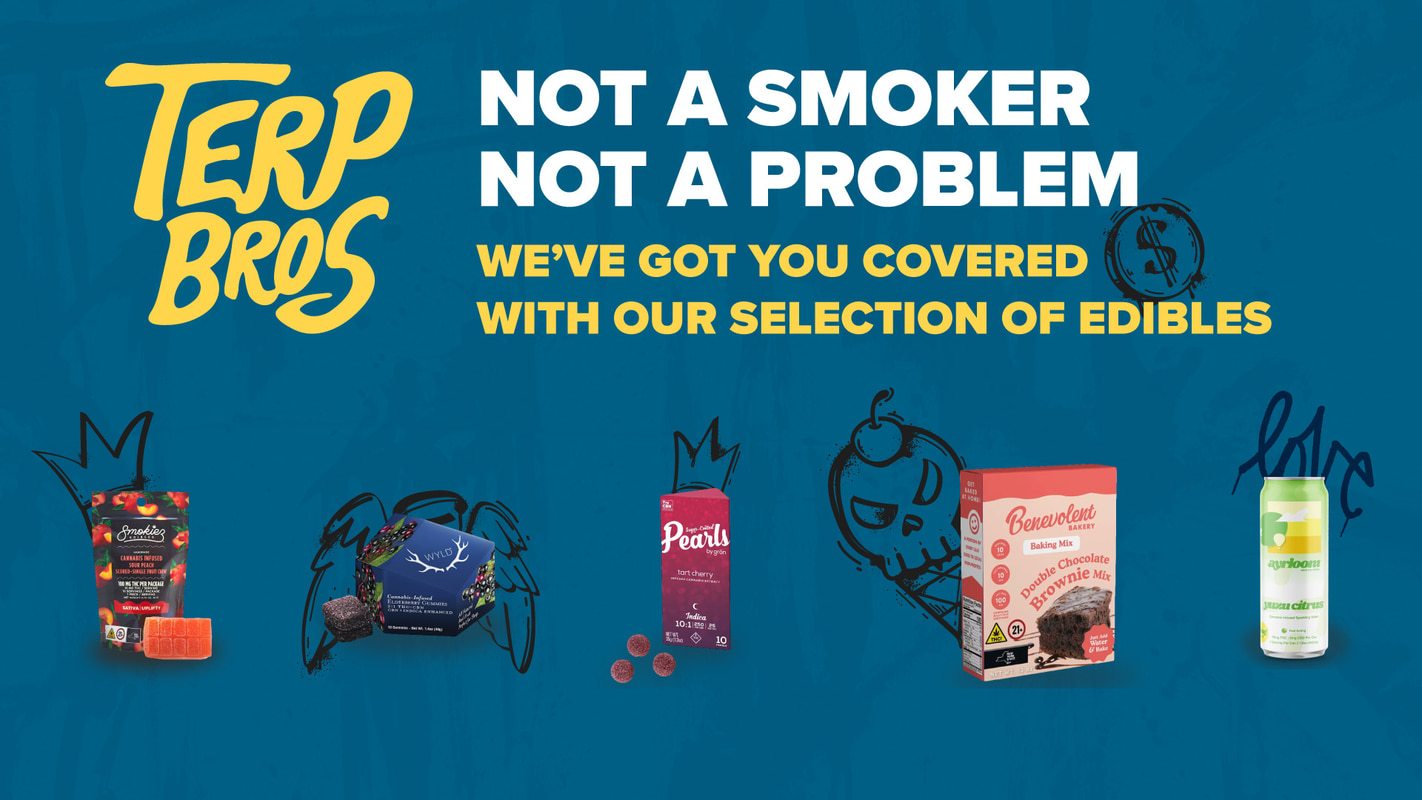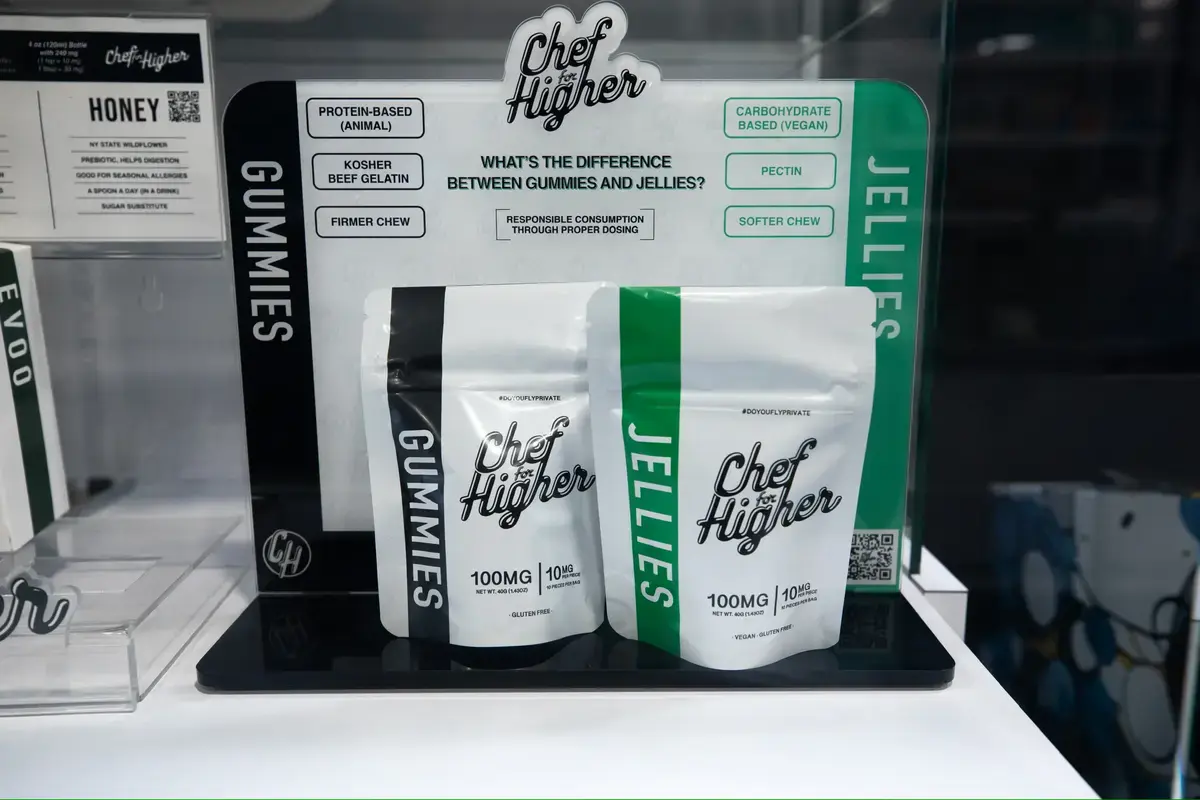
Cannabis Edibles: 10 Essential Facts for Safe, Powerful Use 2025
Why Cannabis Edibles Are Changing How People Consume Cannabis
Cannabis edibles are food and drink products infused with cannabis compounds like THC and CBD that offer a smoke-free way to experience cannabis effects. Unlike smoking or vaping, edibles are consumed orally and processed through your digestive system, creating longer-lasting effects that can persist for 4-8 hours.
Quick Facts About Cannabis Edibles:
- Onset time: 30 minutes to 2 hours
- Peak effects: 2-3 hours after consumption
- Duration: 4-8 hours total
- Recommended starting dose: 2.5-5 mg THC
- Common types: Gummies, chocolates, beverages, baked goods
- Legal limit in New York: 10 mg THC per package
The appeal of edibles goes far beyond avoiding smoke. They offer precise dosing, discreet consumption, and effects that many users describe as more body-focused compared to inhaled cannabis. From ancient Indian bhang dating back to 1000 BC to today’s precisely dosed gummies, edibles represent one of humanity’s oldest and most refined methods of cannabis consumption.
Modern edibles have exploded in popularity because they solve common problems people face with other consumption methods. There’s no smell, no special equipment needed, and no learning curve – just eat and wait. However, that simplicity can be deceiving. The delayed onset and longer duration require a different approach to dosing and timing.
I’m Jeremy Rivera, owner of Terp Bros dispensary in Astoria, and I’ve helped thousands of customers steer their first cannabis edibles experience through our community-focused approach to cannabis education. My journey from cannabis-related convictions to becoming a licensed dispensary owner through New York’s social equity program has taught me the importance of responsible, informed consumption.
What Are Cannabis Edibles? The Science & History
Cannabis edibles are foods and drinks that have been infused with activated cannabis compounds. The magic happens through a process called decarboxylation – basically, heating the cannabis to wake up the THC and CBD so your body can actually use them.
Here’s where things get interesting: when you eat a cannabis edible, your body handles it completely differently than smoking or vaping. Instead of going straight to your bloodstream through your lungs, the THC takes a scenic route through your digestive system and liver. Your liver acts like a chemistry lab, converting regular THC into something called 11-OH-THC (11-hydroxy-THC). This new compound is often more potent and definitely longer-lasting than what you’d get from smoking.
THC (Tetrahydrocannabinol) is the star of the show – the compound that gets you high. CBD (Cannabidiol) is the mellow cousin that won’t get you high but might help with relaxation and other wellness benefits. You’ll also find CBG (Cannabigerol) and CBN (Cannabinol) in some edibles, especially those designed for sleep or specific effects.
The first-pass metabolism through your liver is why edibles can feel so different from other consumption methods. Some people describe the effects as more body-focused, others find them more intense. Either way, this liver conversion is why patience is absolutely crucial with edibles – you’re literally waiting for your body to create the compound that will affect you.
History of Cannabis Edibles
The story of edibles starts way before anyone was making gummies in commercial kitchens. We’re talking ancient history here – around 1000 BC in India, people were already mixing cannabis into a drink called bhang. This wasn’t just some casual beverage; it was (and still is) part of religious festivals like Holi.
Around the same time, North African Berber tribes were creating majoun – think of it as the world’s first cannabis energy bar. They’d mix cannabis with honey, nuts, and spices to create a jam-like treat. These early edibles weren’t just for fun; they were often used for spiritual ceremonies and healing.
The Western world took a lot longer to catch on. Alice B. Toklas changed that in 1954 with her famous cookbook that included “Hashish Fudge.” The real game-changer came with legalization movements starting in the 1990s. What began as unpredictable homemade brownies has evolved into precisely dosed products with consistent effects.
Modern Cannabis Edibles Market
Today’s edible scene is incredibly diverse. Gummies and soft chews dominate the market because they’re easy to dose, taste great, and last forever on the shelf. Chocolates remain popular because they hide the cannabis taste better than almost anything else. Beverages are becoming the go-to alcohol alternative, with some using nano-emulsion technology to kick in faster than traditional edibles.
At Terp Bros, we’ve seen how the edible market has matured. Our customers in Astoria and throughout Queens appreciate having reliable, lab-tested options with clear dosing information. The science behind edible effects continues to evolve as researchers study how different cannabinoids interact with our bodies through oral consumption.
Types of Edibles & How They’re Made
Walking into a modern dispensary, you’ll find cannabis edibles in forms that would amaze those early bhang drinkers from 1000 BC. The days of mystery brownies with unpredictable effects are long gone, replaced by precisely dosed products that look and taste like regular treats.
Gummies and soft chews rule the edibles world, and for good reason. These colorful, fruit-flavored treats make dosing simple – each piece typically contains exactly 2.5, 5, or 10 mg of THC. Chocolates and confections offer a more indulgent experience. The rich cocoa naturally complements cannabis flavors instead of fighting them, while the fat content in chocolate actually helps your body absorb the cannabinoids more effectively.
Beverages represent the cutting edge of edible technology. Cannabis-infused drinks range from sparkling waters to coffee alternatives, with some using nano-emulsion technology that can deliver effects in as little as 15-30 minutes. Baked goods remain popular for their familiar comfort. Traditional cookies, brownies, and pastries made with cannabis butter or oil often have a more noticeable cannabis flavor.
Capsules and pills serve people who want the benefits without any taste at all. These pharmaceutical-style products provide precise dosing and predictable effects, making them popular with medical users who need consistent results.
The magic happens in how these products are made. Commercial edibles start with cannabis extract or distillate that’s been precisely tested for potency. This extract gets incorporated into the food using various binding agents and emulsifiers to ensure every gummy or chocolate square contains exactly the same amount of THC.
At Terp Bros, we stock professionally made edibles that undergo rigorous testing for both potency and purity. You can browse our complete selection of edibles to find the format that matches your preferences and experience level.
Cannabis Edibles vs. Sublinguals & Beverages
Not all products you put in your mouth work the same way. Traditional cannabis edibles like gummies, chocolates, and baked goods must take the scenic route through your digestive system. They need to be broken down in your stomach, absorbed in your intestines, and processed by your liver before you feel anything. This journey takes 30 minutes to 2 hours, but the effects last 4-8 hours.
Sublingual products like tinctures, strips, and mints work differently. They’re absorbed through the mucous membranes under your tongue, bypassing your digestive system entirely. This direct route means you’ll feel effects in 15-45 minutes, but they typically last only 2-4 hours.
Fast-acting beverages use nano-emulsion technology to create tiny cannabinoid particles that your body can absorb quickly. Like sublingual products, they can kick in within 15-30 minutes and last 2-4 hours, making them popular with people who want more control over their timing.
How Do Cannabis Edibles Work? Onset, Duration & Dosing
When you bite into a cannabis edible, you’re starting a journey that’s completely different from smoking or vaping. Understanding this process isn’t just academic – it’s the key to having a safe, enjoyable experience instead of an overwhelming one.
Here’s what happens when you consume an edible: First, it breaks down in your stomach just like any other food. Then, the cannabinoids get absorbed through your intestinal walls and travel to your liver. This is where things get interesting – your liver doesn’t just pass the THC along unchanged. Instead, it converts THC into a compound called 11-OH-THC (11-hydroxy-THC), which is actually more potent and longer-lasting than regular THC.
This liver conversion process, called first-pass metabolism, is why edibles can feel so much stronger than smoking the same amount of THC. Your liver is essentially creating a more powerful version of the compound, which then enters your bloodstream and reaches your brain.
The timeline for cannabis edibles is very different from other consumption methods. Onset typically takes 30 minutes to 2 hours – sometimes even longer if you’ve eaten a big meal. Peak effects hit around 2-3 hours after you’ve consumed the edible, and the total duration usually lasts 4-8 hours.
Several factors affect how quickly and strongly you’ll feel effects. Your body weight and metabolism play a huge role – people with faster metabolisms often feel effects sooner. What you’ve eaten recently matters too – a full stomach can delay onset significantly. Your cannabis tolerance, the specific product and dose, and your individual body chemistry all influence your experience.
| Consumption Method | Onset Time | Peak Effects | Duration | Metabolism |
|---|---|---|---|---|
| Edibles | 30-120 minutes | 2-3 hours | 4-8 hours | Liver (11-OH-THC) |
| Smoking/Vaping | 2-10 minutes | 10-30 minutes | 1-3 hours | Lungs (THC) |
Safe Dosing for New Users of Cannabis Edibles
If you’re new to cannabis edibles, dosing isn’t just important – it’s everything. Unlike smoking, where you can feel effects immediately and decide to stop, edibles require patience and planning. Once you’ve swallowed that gummy, you’re committed to the ride.
For complete beginners, start with 2.5 mg THC. This might sound incredibly low, but many people feel noticeable effects at this dose. Occasional cannabis users should consider 5 mg THC as their starting point. Regular users can typically handle 10 mg THC, while experienced users might need 15-20 mg THC or more.
The biggest mistake new users make is taking more because they don’t feel anything after 30 or 60 minutes. Here’s your safe consumption protocol: Start with 2.5-5 mg THC and wait at least 2 hours before even considering taking more. Keep a journal of your experiences – note the dose, timing, what you ate, and how you felt. Gradually increase your dose by 2.5 mg increments in future sessions.
For more comprehensive guidance on cannabis consumption, check out our Cannabis 101 resource.
Comparing Cannabis Edibles to Smoking and Vaping
Cannabis edibles shine when you want longer-lasting effects – we’re talking 4-8 hours compared to 1-3 hours from smoking or vaping. They’re completely discreet with no smell or visible vapor, making them perfect for situations where you need to be subtle. There’s no lung irritation or respiratory effects, which is important for people with breathing concerns.
However, edibles come with trade-offs. The delayed onset makes dosing tricky – you’re essentially making a commitment without knowing exactly what you’re getting into. The longer duration can be problematic if you take too much and need the effects to stop.
Smoking and vaping offer immediate effects that allow for easy dose control – you can take a puff, wait a few minutes, and decide if you want more. The shorter duration (1-3 hours) gives you more flexibility in your day. The downsides of inhalation include potential respiratory irritation from smoking and obvious smell and visibility that makes discretion difficult.
Benefits, Risks & Safe Consumption Practices
Cannabis edibles have become popular for good reasons. They offer unique advantages that other consumption methods simply can’t match, but they also require a different level of respect and caution.
For medical users, the longer-lasting effects of edibles make them particularly valuable for chronic pain management. Instead of needing to medicate every few hours like with smoking, one properly dosed edible can provide relief for an entire workday or help someone sleep through the night without waking up in pain.
Many people find edibles helpful for sleep disorders because the effects can last 6-8 hours – perfect for a full night’s rest. The body-focused effects tend to be more relaxing and sedating compared to the more cerebral high from smoking or vaping. Appetite stimulation is another area where edibles shine, especially for cancer patients undergoing chemotherapy who struggle with nausea and loss of appetite.
From a recreational standpoint, edibles have become popular alcohol alternatives at social gatherings. They’re incredibly discreet – no smell, no visible consumption, and no special equipment needed.
The biggest safety concern with cannabis edibles is also their biggest advantage: they look and taste like regular food. This creates serious risks for accidental ingestion by children and pets. Since legalization, poison control centers have reported increased calls about children accidentally consuming edibles that looked like regular candy or cookies.
Proper storage is absolutely critical. Always keep edibles in their original, labeled packaging and use child-resistant containers or lockboxes. Never leave them in common areas or mixed with regular food. Your pets are also at risk – cannabis can be toxic to dogs and cats, so the same storage precautions apply.
Overconsumption is the other major risk. Because effects take so long to appear, it’s easy to take too much while waiting to feel something. Signs include severe anxiety, rapid heart rate, nausea, confusion, and extreme drowsiness. While cannabis has never caused a fatal overdose, overconsumption can be extremely unpleasant and last for many hours.
Cannabis can interact with various medications, particularly blood thinners, seizure medications, heart medications, and sedatives. If you take prescription medications, consult with a healthcare provider before trying edibles.
For more detailed safety information, check out this scientific research on safety from health experts.
Potential Side Effects & How to Handle Them
Even when you do everything right, cannabis edibles can still cause side effects. Dry mouth is probably the most common side effect. Keep water nearby and sip regularly. Increased appetite (the famous “munchies”) is another common effect. Plan ahead by having healthy snacks available.
Drowsiness is expected, especially with higher doses or indica-dominant products. Never drive or operate machinery after consuming edibles, even if you feel fine. Mild anxiety can happen, particularly if you’re in an unfamiliar environment or took more than intended. Practice deep breathing and remind yourself that the feeling will pass.
More serious signs of overconsumption include severe anxiety or panic, rapid or irregular heartbeat, nausea and vomiting, hallucinations, or extreme confusion. While scary, these effects will eventually subside.
If you’ve taken too much, stay calm first and foremost. Cannabis has never caused a fatal overdose, though it can certainly feel overwhelming. Find a safe, comfortable space with people you trust. Hydrate with water but avoid alcohol, which can make effects worse. Distract yourself with calming activities like listening to music, watching something light, or taking a warm shower.
Seek medical help if symptoms are severe, if you’re having trouble breathing, or if you’re genuinely concerned about your safety. The effects will eventually end, typically within 6-8 hours, though you might feel residual effects for up to 24 hours.
New York Laws, Purchasing Tips & Responsible Enjoyment
New York has created a thoughtful legal framework for cannabis edibles that puts safety first while giving adults the freedom to make their own choices. These laws aren’t just bureaucratic red tape – they’re designed to protect consumers and ensure you get quality products.
The most important rule to remember is the age requirement of 21 or older for any cannabis purchase. The state has also set a maximum THC limit of 10 mg per individual edible piece, which might seem low if you’re coming from other states, but it’s actually perfect for safe dosing.
Child-resistant packaging is mandatory for all edibles, and there’s a good reason for this. These products often look exactly like regular candy or baked goods, making them dangerously appealing to kids. The packaging requirements also include clear labeling that shows exactly how much THC and CBD is in each piece and in the entire package.
New York allows you to possess up to 3 ounces of cannabis flower equivalent in edibles, which translates to quite a bit of product. However, you can only purchase these products from state-licensed dispensaries – the days of buying from unlicensed sources are over, and for good reason.
When you’re shopping for edibles, look for products with clear labeling that shows THC and CBD content per serving. Quality dispensaries will also provide third-party testing results that verify potency and check for contaminants like pesticides or heavy metals.
At Terp Bros, we’re proud participants in New York’s CAURD program (Conditional Adult-Use Retail Dispensary), which prioritizes licenses for people from communities that were hurt most by cannabis prohibition. This social equity approach means that folks who suffered under the old laws can now benefit from legalization.
Our commitment goes beyond just selling products. We’re actively supporting justice-involved individuals through employment opportunities and business partnerships. We believe in providing education for safe cannabis consumption because knowledge is power. Our delivery service throughout Queens improves access for people who might have trouble getting to a physical store.
When you choose licensed dispensaries like us, you’re supporting products that undergo rigorous testing for safety and potency. You’re also supporting a business model that gives back to the community. You can browse our complete selection of tested, legal cannabis products in our shop.
Responsible enjoyment means never driving under the influence of cannabis – this should go without saying, but it’s worth repeating. Don’t consume edibles at work or in public spaces, and always start with low doses while waiting for full effects. Keep your consumption private and away from minors, and respect others who choose not to consume cannabis.
We offer convenient delivery throughout Queens, including Astoria, Woodside, Jackson Heights, East Elmhurst, Maspeth, Elmhurst, Sunnyside, Flushing, Jamaica, Fresh Meadows, Kew Gardens, College Point, Rego Park, Middle Village, Forest Hills, Richmond Hill, South Richmond Hill, Whitestone, and Corona. This ensures safe, legal access to quality cannabis edibles without the hassle of traveling to a dispensary.
Frequently Asked Questions About Cannabis Edibles
After guiding thousands of customers at Terp Bros, these are the questions we hear most often.
How long do cannabis edibles stay in your system?
Testing windows vary by method:
- Saliva: roughly 1–3 days
- Blood: about 3–4 days
- Urine: 3–7 days for occasional users, 30+ days for frequent users
- Hair: up to 90 days
Metabolism, body weight, and dose all matter, and there’s no proven way to “flush” THC faster—only time works.
Can I mix alcohol or prescriptions with cannabis edibles?
Avoid combining edibles with alcohol; the two can amplify impairment and nausea. If you take blood thinners, seizure, heart, or sedative medications, consult your healthcare professional before using edibles—interactions can change how either substance works.
What should I do if I’ve consumed too much?
- Stay calm and find a safe, comfortable space.
- Sip water and avoid alcohol or caffeine.
- Distract yourself with calming music, deep breathing, or a nap.
- Effects peak around 2–3 hours and taper off within 6–8 hours.
- Seek medical help for severe anxiety, chest pain, or vomiting you can’t control.
Cannabis won’t cause a fatal overdose, but it can feel overwhelming—“start low and go slow” prevents most bad trips.
Are homemade edibles safe?
Home kitchens struggle with even dosing and lab-level food safety. One brownie could contain 5 mg THC and the next 50 mg. For reliable potency and contaminant testing, stick to licensed dispensaries.
How do I choose the right edible for me?
- Beginners: 2.5 mg THC; occasional users: 5 mg.
- Consider how long you want effects—edibles last 4–8 hours.
- Pick a flavor or format you’ll actually enjoy (gummies, chocolates, beverages, capsules).
- Check child-resistant packaging if you live with kids or pets.
- Focus on cannabinoid ratios (THC, CBD, CBN) rather than strain names.
What’s the difference between indica and sativa edibles?
Because the liver metabolizes THC into the same compound (11-OH-THC), traditional indica vs. sativa labels matter less with edibles. Cannabinoid content and your individual biology shape the experience far more.
Can I travel with cannabis edibles?
Never cross state lines with any cannabis product—federal law still applies. Within New York, keep edibles in original, sealed packaging and avoid consuming in vehicles or public spaces. When visiting another legal state, plan to purchase locally.
For more answers, visit our full FAQ page, or stop by Terp Bros in Astoria—or order delivery anywhere in Queens—for personalized guidance on safe, enjoyable cannabis consumption.









